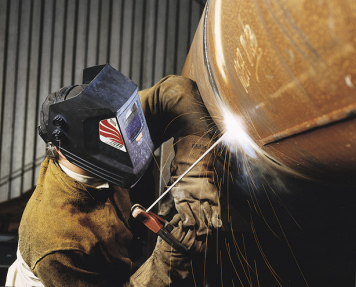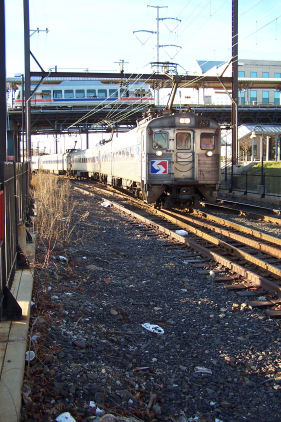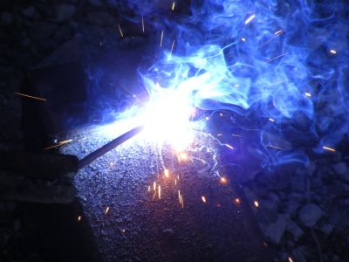Philadelphia’s public transit system has been thrown into disarray for the second time in eight months with dozens of railcars being taken out of service due to cracks that developed along welded support structures. In July 120 cars were pulled from Southeastern Pennsylvania Transportation Authority’s regional rail fleet to repair cracks that developed in the cars’ undercarriages. This week 58 cars on SEPTA’s Market-Frankford elevated train (the El) fell victim to similar problems.
The sudden loss of cars has caused major delays and congestion on platforms and in cars. It’s also inspired many riders to seek alternate sources of transportation and raised even more questions about how faulty welds are able to cripple huge parts of a public transit system.
Richard Knight, PhD, a teaching professor and associate head of Drexel’s Department of Materials Science and Engineering in the College of Engineering, has an extensive background in thermal plasma processes and materials diagnostics. He was able to shed some light on the process of welding, how defects can occur and the precautions taken to identify and prevent them.
This is the second time in a year that key components of SEPTA cars have malfunctioned due to faulty welds. What are some of the aspects of the welding process that could weaken a weld if not performed properly?
 Welding of metals involves locally melting and fusing (icing together) the material on either side of a joint. This necessitates the use of high intensity sources of heat energy —possibly a combustion flame, but more likely an electric arc. In so-called “stick welding” or “TIG” (tungsten inert gas) welding, the heat source is used to melt a “filler rod” to add some of the material needed to fill in the joint. The goal is to fuse or join together the two parts being welded into a larger piece, while maintaining the desired alignment, dimensions and properties of the welded item.
Welding of metals involves locally melting and fusing (icing together) the material on either side of a joint. This necessitates the use of high intensity sources of heat energy —possibly a combustion flame, but more likely an electric arc. In so-called “stick welding” or “TIG” (tungsten inert gas) welding, the heat source is used to melt a “filler rod” to add some of the material needed to fill in the joint. The goal is to fuse or join together the two parts being welded into a larger piece, while maintaining the desired alignment, dimensions and properties of the welded item.
Some metals are easier to weld than others. Steels are relatively easy to weld. Aluminum, on the other hand, is not. Aluminum is lighter and less dense than steel, but it is much more difficult to weld because aluminum oxidizes very easily. If aluminum is exposed to air during welding, it forms a ceramic compound called “alumina.” The presence of alumina in a weld would tend to make it brittle and weak.
Industry has many, many years experience welding steels and iron-based alloys, but aluminum requires a different welding technology.
Could the heat associated with welding actually weaken the surrounding structure?
During welding there are typically steep temperature gradients between the weld zone itself and the bulk of the material on either side of the joint. Most metals expand when they are heated to extreme temperatures, which can lead to residual stresses between the welded region and the rest of the component. If not properly relieved, these internal stresses can contribute to the growth of internal flaws (cracks) over time, especially when the welded component is subjected to high forces and cyclic (repetitive) loads during use.
Stress relieving can be carried out by a post-weld heat treatment. This would mean heating the welded piece to an appropriate temperature in an oven or furnace, or in place if the welded item is too large to fit into a furnace.
Welding also typically changes the internal structure — what we call grain size and grain orientation — of the metal in and around the weld region. This can also change the properties of the material, including its strength.
Done properly, a welded joint can be as strong as — maybe even stronger than — the bulk material. In-use physical mechanical damage and/or corrosion can also degrade the strength and reduce the lifetime of a welded component.
How can you tell if a weld has been done properly?
Some level of inspection or testing of a welded joint may be incorporated into the job specification too. This could include visual inspection, X-ray inspection (for very critical components), and non-destructive testing techniques such as ultrasound, magnetic particle testing, and dye-penetrant testing. These tests are to look for internal and surface cracks, pits, etc. that could cause a joint to be weak, or could open up and grow into a crack during the lifetime of the item.
 It is likely that the cracks in the SEPTA components didn’t suddenly appear overnight. If the cause is fatigue, then the cracks would have started out small — undetectable to the naked eye — and then grown over time with the cyclic loading and unloading that the parts experience in their daily use — bouncing up and down, etc. How quickly the cracks were detected would depend on SEPTA’s inspection intervals.
It is likely that the cracks in the SEPTA components didn’t suddenly appear overnight. If the cause is fatigue, then the cracks would have started out small — undetectable to the naked eye — and then grown over time with the cyclic loading and unloading that the parts experience in their daily use — bouncing up and down, etc. How quickly the cracks were detected would depend on SEPTA’s inspection intervals.
The manufacturing process may also include some testing of the mechanical behavior, or strength, of a welded joint, likely using standardized test samples, tested under laboratory conditions. This could include measuring the yield strength, ductility, modulus, etc. For components that are to be subjected to fluctuating (cyclic) loads while in service some “fatigue” tests might be carried out as well — this would all be part of the design specification.
The most recent cracks are on welds that attached vent boxes to the body bolster (a part where the wheel structure attaches to the carriage’s main body). There is speculation that the vent boxes aren’t as strong as the bolster and this led to the cracks — how does the type of material to which something is welded affect the durability of the weld itself? Are there adjustments that can be made in the welding process, or the type of weld used, that could help counter a relatively weak substrate?
It all depends on how and where any forces acting on the components are located and whether the forces are compressive — which tend to push things together, and tends to discourage cracks from opening — or tensile — which tend to pull things apart, causing small cracks to grow over time. An analysis of the stresses and forces any component will be subjected to during use would likely be a part of the design process.
Designs normally include a safety factor as well. So if a component is supposed to operate at a certain load, then it would likely be designed to withstand a load that is actually several times more than its standard load.
The higher the safety factor, the larger, heavier, bulkier and more expensive the component will be. Different industry sectors conform to different norms with respect to safety factors. Some industries are more conservative than others though. For instance, a pressure vessel for a nuclear reactor or the hull of a nuclear submarine are much more conservatively designed than the chassis of an automobile might be. It all comes down to risk analysis and cost, and the consequences of the part failing.
It’s tough to make generalizations without seeing what is connected to what in this case, and where exactly the failure has occurred. Is the same for all bolsters? Have they all been in service for the same length of time? Are all the designs the same? Are they all from the same manufacturer? Do they conform to the design specification? Is the problem a design problem or a manufacturing problem? Are there signs of corrosion? These are all questions that need to be answered as the source of the defect is investigated.
When choosing the material that is used for the weld, how does one consider the relative stress that it will be under and how does that affect the choice of material? What are some of the materials typically used in welding?
The design should specify the geometry and location of any welded joints required during manufacture of a component. The “spec” would also indicate the type of welding to be used (gas, stick, TIG, electron beam, laser, etc.).
 Filler rods used for stick welding would be specified based on the composition of the base metallic alloy parts being welded together. These rods are usually a composite of the particular alloy and “fluxing” materials, which help clean the surfaces of the joint during welding and minimize oxidation of the hot metal.
Filler rods used for stick welding would be specified based on the composition of the base metallic alloy parts being welded together. These rods are usually a composite of the particular alloy and “fluxing” materials, which help clean the surfaces of the joint during welding and minimize oxidation of the hot metal.
Molten metal exposed to air will tend to oxidize. Metallic oxides are much more brittle than metals, and oxides are generally undesirable in welded joints. After a weld has been completed it is normal for the welder to clean off any residual slag or dross. Welded joints may also be cleaned up by grinding the joint area so it looks flat. Any local holes or “pits” should be exposed during this step and may be re-welded to fix the problem. Post-weld inspection is important.
A big part of the deal would also be the use of qualified/certified welders, experienced in welding the materials in question. I’d expect the manufacturer would have been properly approved, but I have no knowledge of SEPTA’s procurement protocols.
How long should a typical weld last?
This depends on the quality of the weld and the conditions it has been subjected to in use. If it was properly designed and used within its design specification and operating conditions, then it should last a long time. Weak welds, or welds stressed outside of their design parameters would fail sooner. The environment would also play a role when you consider factors like corrosion and humidity.